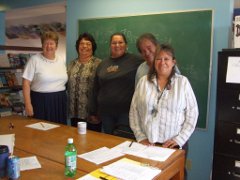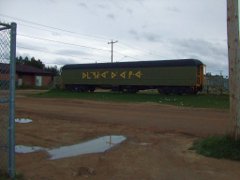Development of a Wholistic Accountability Framework for the Native Literacy Stream
Peterborough Native Learning Centre
Peterborough, Ontario
Our research question

Wasauksing Circle - missing is Chief Wilfrid King.
How can we more reliably capture success in the Native literacy stream?
Progress
The current Ontario Ministry of Training, Colleges and Universities' (MTCU) program monitoring form has been enhanced by our team with the goal of providing Native literacy programs with assistance in showcasing success and translating MTCU accountability-related items into language and examples that are relevant to Native programs. We hope to clarify information that the original form is asking for and assist Native programs to include examples of their performance that indicate successes despite the barriers rather than highlight the barriers to success.
Four community site visits have been made and each of the four community literacy programs have received comprehensive assessment packages and field support.
Data recorded to date is being analyzed according to the 8 key indicators of success identified by research of successful Aboriginal schools:
- Governance and Leadership
- Partnerships
- School Climate
- Curriculum and Programs
- Teaching/Learning
- Aboriginal Language
- Culture and History
- Assessment for Learning and Outcomes
Accomplishments
- We made minor revisions to the monitoring tool after the first visits because the programs revealed additional areas (reflecting their realities) that needed to be included. We resent the revised tool to the participant programs.
- Four visits were completed between September 8 and October 17.
- Two programs had the opportunity of touching base with us at the annual Ontario Native Literacy Coalition Gathering in November.
- The team has developed a good working relationship with all four programs and practitioners as we have kept in regular contact since the visits.
- Some short term and medium term changes in the programs have already taken place.
Challenges

Cree welcome on the side of a rail car
- The eight key indicators of success are very much interconnected. Taking a model that is wholistic in nature and relating it to the more linear model currently in use has been difficult
- A misunderstanding within the team regarding the use of and what was seen as revisions to a government tool raised some concerns that have since been eased.
- Communications with participating programs sometimes poses a problem. They are quick to ask for help but slow to respond to requests from the team.
- Determining what kind of help to offer when our communities, support, personalities and expertise are very different from the participant programs has had us wondering at times if we’re suggesting the right courses of action. For example, to recruit learners, to deal with community image, to establish partnerships—will our experience transfer to Moosonee? To an island? To a small reserve?
- Working with this level of intensity with the participating programs while running our own Native literacy program with its own set of challenges has been a juggling act.

